Exploring the Metro Red Line: A Deep Dive into Dubai
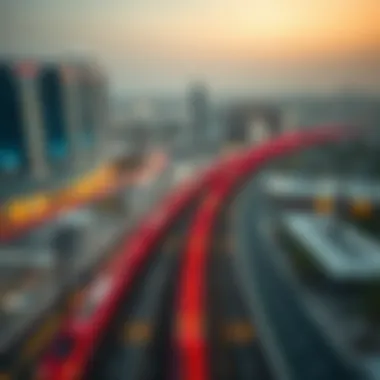
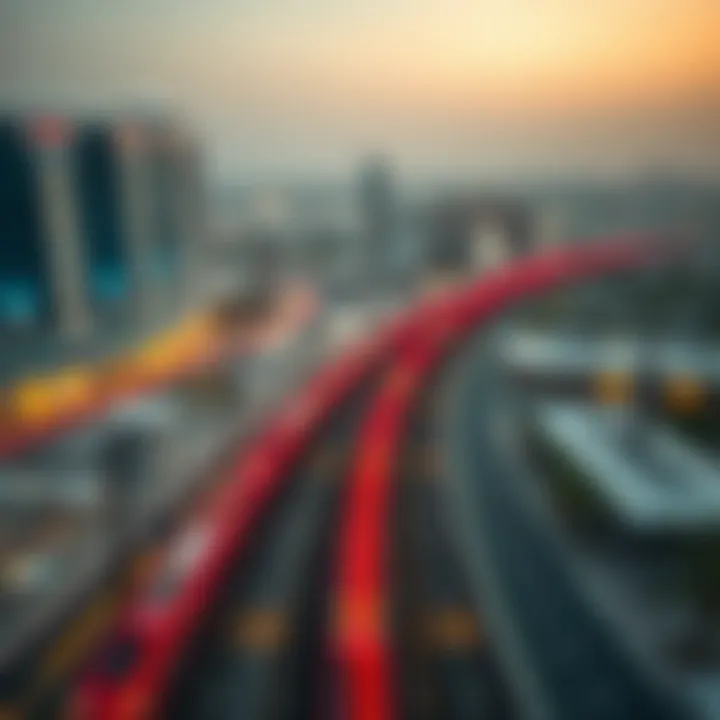
Market Insights
The Metro Red Line in Dubai significantly impacts both transportation dynamics and the real estate sector. Recognizing the current trends in Dubai's real estate market is crucial for potential investors and stakeholders.
Current Trends in Dubai Real Estate
Dubai's property market has seen seismic shifts due to various factors, such as population growth, international investments, and government policies aimed at attracting expatriates. Recent data illustrates a robust demand for residential properties near metro lines, underscoring the importance of public transport in shaping buyer preferences. As remote work trends continue to evolve, many individuals prioritize accessibility and convenience, influencing where and what they choose to buy or rent.
Key objectives that shape these trends include:
- Demand for Proximity: Properties within close vicinity to the Metro Red Line attract higher interest from homebuyers and investors alike.
- Increased Rental Demand: As more residents prefer commuting via the metro, rental prices in neighborhoods near metro stations have seen an uptick.
- Focus on Sustainability: There's a strong movement towards sustainable living, with metro connectivity enhancing public transport use and reducing reliance on personal vehicles. This is not just environmentally friendly but also economical for residents.
Key Indicators of Market Performance
To gauge the pulse of the property market influenced by the Metro Red Line, consider these key indicators:
- Sales Volumes: An upsurge in sales of properties near metro stations showcases the increasing desirability of these locations.
- Rental Yields: Areas close to public transport tend to deliver higher rental yields compared to those far removed from metro access.
- Development Activity: The rise in new residential projects around metro stations reflects strong investor confidence.
The integration of the Metro Red Line has redefined urban mobility and property values, proving essential in the city’s fast-paced growth.
Investment Strategies
Navigating Dubai's vibrant real estate landscape requires savvy approach, especially when considering properties near the valuable Metro Red Line.
Smart Buying Tips for First-Time Investors
For those diving into the property market for the first time, some strategies can make a substantial difference:
- Research Neighborhoods: Take the time to understand the amenities and lifestyle options in areas serviced by the Metro.
- Consult Local Experts: Engage with realtors who have extensive knowledge of the market and can provide insights on future developments.
- Visit Properties: Don't rely solely on virtual tours. Physical visits to potential investments can provide invaluable perspective.
Understanding Rental Yields and ROI
In a competitive market, grasping how to assess rental yields is vital. Properties near the Metro Red Line often yield:
- Consistent Demand: High tenant interest leads to less vacancy and stable income.
- Attractive Yields: Investors often see higher rental returns within a short timeframe due to location advantages.
- A Balanced Investment Portfolio: Combining properties around metro stations with other investments can mitigate risks and enhance overall returns.
To keep abreast of the ever-changing market conditions, resources like Dubai Land Department and property market analysis sections in Gulf News offer extensive insights.
Understanding the nuances of the Metro Red Line's impact on real estate not only facilitates informed investments but also enriches the living experience within cosmopolitan Dubai.
Preface to the Metro Red Line
The Metro Red Line in Dubai stands as a testament to the city’s rapid growth and innovation in public transportation. As one of the most significant projects in the urban landscape, it plays a pivotal role in shaping the daily lives of residents and visitors alike. Understanding the Red Line is vital for various stakeholders, including investors, homeowners, and city planners, as it affects real estate dynamics, commuter convenience, and overall economic development.
Overview of the Metro System
The Dubai Metro is a sophisticated network that comprises several lines, with the Red Line being the first operational line. Launched in September 2009, the metro system operates in a driverless, fully automated mode, showcasing cutting-edge technology and a commitment to efficiency. The Red Line stretches approximately 52 kilometers, linking vital areas across the city.
Key Features of the Metro System:
- Driverless Operation: The entire system is automated, ensuring safety and efficiency in operations.
- Station Design: Stations are designed with modern aesthetics and are equipped with essential services, catering to a diverse range of commuters.
- Sustainability Commitment: The metro is a cleaner mode of transport, aimed at reducing road congestion and minimizing environmental impact.
Commuters have the advantage of seamless access to malls, educational institutions, and business hubs. This accessibility further enhances the desire for urban living, as more people are inclined to reside near metro stations. The significance of the Red Line thus escalates, influencing economic and developmental decisions in a manner that reaches beyond mere transportation.
Evolution of the Red Line
Since its inception, the Red Line has undergone remarkable transformations and expansions. Initially stretching from Rashidiya to UAE Exchange, it has now become a backbone of public transport for internal and external mobility within Dubai. The evolution reflects the city's visionary approach to future-proof its infrastructure against the challenges of urban sprawl and increasing population density.
Historical Milestones:
- Construction Phase (2006-2009): The ambitious project involved complex engineering feats, as it traversed through crowded urban areas and required innovative tunneling techniques.
- Extensions and Enhancements: Rapidly increasing demand led to extensions in the subsequent years, connecting suburban areas and reducing travel times.
- Integration with Other Transport Modes: The introduction of feeder buses and now tram lines has made commuting more cohesive, allowing for easy transfers between different modes of transport.
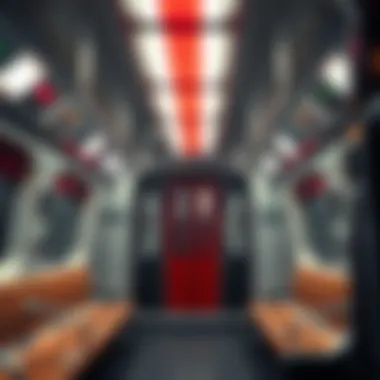
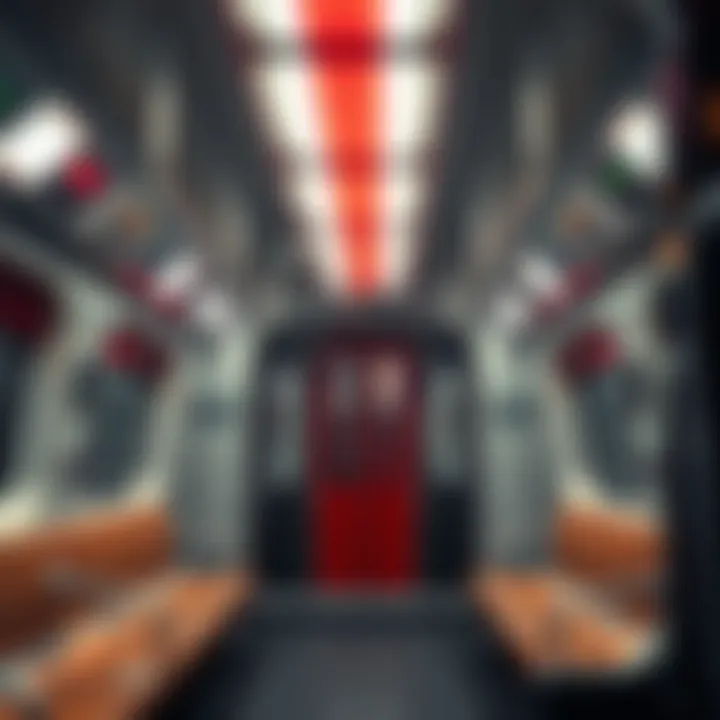
In essence, the journey of the Red Line is not just about connecting stations; it's about weaving a fabric of urban mobility that enhances the quality of life in Dubai. Through its growth, the Red Line continues to reflect the ambitions and aspirations of a city that refuses to stand still.
Key Features of the Metro Red Line
The Metro Red Line is a significant part of Dubai's extensive public transport network. It stands as a testament to both the city's ambitious urban planning and its commitment to modernity. This section outlines the major features that make the Red Line an essential asset for residents and visitors alike.
Stations and Connectivity
List of Stations
The Metro Red Line boasts a range of stations, encompassing 29 in total. Each station serves as a crucial node, connecting key neighborhoods and attractions. Stations like Burj Khalifa/Dubai Mall, or Mall of the Emirates, cater not only to commuters but also to tourists eager to explore these iconic sites. The strategic placement of these stations ensures that the line serves both daily travelers and those visiting the city for leisure.
Characteristic: The stations are designed with user experience in mind, offering amenities like access to shopping areas and other public transport options.
One unique aspect is the Dubai Mall station, which is built primarily to facilitate access to one of the world’s largest shopping centers, enhancing its popularity among both locals and tourists.
However, the challenge lies in ensuring that all stations maintain sufficient flow during peak hours, especially at those frequented by tourists.
Interconnections with Other Lines
The Metro Red Line is well-integrated with other transport networks, including the Green Line, which provides seamless transitions for commuters. This interconnectivity allows passengers to transfer easily between different parts of the city, significantly enhancing the public transport experience.
Characteristic: The interconnections are positioned thoughtfully to facilitate smooth transitions, thus reducing travel time.
Notably, stations like Union and Burjuman serve as major interchange points, allowing for convenient access across multiple lines. While this is a significant advantage, the complexity of transfers can sometimes overwhelm new users, especially during rush hour.
Accessibility Features
In terms of accessibility, the Metro Red Line is designed to cater to individuals with disabilities. Elevators, escalators, and tactile guidance paths are available at various stations, ensuring that everyone can navigate the system comfortably.
Characteristic: High priority is given to providing inclusive access.
For instance, all trains are equipped with spaces for wheelchairs, and audio announcements help visually impaired commuters. Still, ongoing assessments and improvements are necessary to address any remaining gaps in accessibility, as this remains a critical concern for many.
Train Operations and Scheduling
Frequency of Service
With a train frequency of approximately every 3 to 7 minutes during peak hours, the Red Line caters to a high volume of passengers efficiently. This regular service means that commuters face minimal waiting times, making it a reliable option for daily travel.
Characteristic: Such frequency enhances the overall utility of the line as it aligns with the fast-paced lifestyle of Dubai residents.
The major benefit here is reduced congestion on the roads, but further optimization may be needed during peak commuter periods to enhance capacity even more.
Operational Hours
The Red Line operates from 6:00 AM to midnight on weekdays and stays open until 1:00 AM on weekends. These operational hours suit the diverse needs of commuters throughout the day and night, accommodating different work shifts and social activities.
Characteristic: The extended hours on weekends are particularly attractive for nightlife and leisure activities.
While these hours generally meet the demands of the population, there are ongoing discussions about extending service hours further, especially during major events, to boost convenience.
Ticketing System
The ticketing system for the Metro Red Line is straightforward, offering users various options to purchase tickets, ranging from single-journey tickets to multi-ride options. The introduction of the NOL card system has simplified the process, allowing for contactless payments and easy taps for entry and exit.
Characteristic: The NOL card adds efficiency and convenience to the transit experience.
However, some travelers may find it challenging to navigate the different pricing structures, particularly tourists unfamiliar with the system. Continuous education and signage improvements in multiple languages could alleviate this issue.
The Metro Red Line serves as a backbone for Dubai's transportation system, embodying the city’s forward-thinking design principles and commitment to sustainability, all while providing crucial connectivity to its residents and tourists.
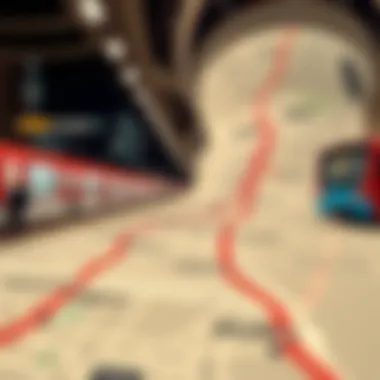
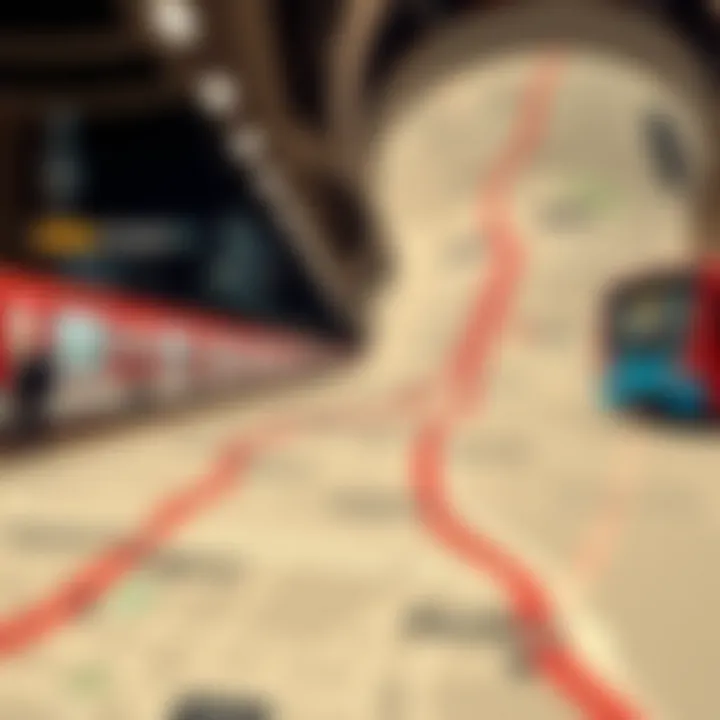
Impact on Dubai's urban landscape
The Metro Red Line has transformed Dubai's urban landscape in multiple ways. As cities evolve in response to myriad pressures—from population growth to economic shifts—the incorporation of a robust public transport system stands out as a crucial element. This design offers residents of Dubai an efficient way to navigate the sprawling city, while also promoting sustainable growth, enhancing property values, and encouraging the development of commercial and recreational spaces.
Real Estate Trends Near the Red Line
The relationship between the Metro Red Line and the real estate market in Dubai is nothing short of symbiotic. Properties located within walking distance of Metro stations have often shown enhanced demand, creating a ripple effect in pricing and desirability. This trend can be attributed to several key factors:
- Accessibility: Living near a Metro station means reduced commuting time, which is a significant draw for many residents. Potential homeowners are increasingly looking for convenience, and a home near a Metro stop checks that box.
- Investment Potential: For investors, properties near the Red Line represent a stable, long-term investment opportunity. Such locations are expected to see a steady appreciation in value, especially as more developments arise in close proximity.
- Desirability of Area: Areas surrounding the Red Line have experienced a surge in amenities. Cafés, shops, and entertainment venues springing up create vibrant neighborhoods that attract families and young professionals alike.
In the context of Dubai, where luxury real estate has historically dominated the market, the Red Line has opened up new avenues for development, particularly for mid-tier apartments and townhouses.
Growth of Commercial Hubs
Another area where the Metro Red Line has significantly impacted Dubai’s landscape is in the establishment and growth of commercial hubs. The availability of efficient transportation networks has typically led to a clustering of businesses in areas with high accessibility. With the Red Line serving key business districts, various sectors, including retail, hospitality, and corporate, have flourished.
- Central Business Districts: Access to the Metro has made areas like the Dubai International Financial Centre (DIFC) even more attractive for corporations seeking office space. Employees who can easily commute via the Metro enhance productivity and attract talent from across the region.
- Retail Opportunities: Alongside corporate growth, there has been a marked increase in retail establishments, with shopping malls and standalone stores benefiting greatly from foot traffic. Places like the Mall of the Emirates, directly accessible via the Metro, have thrived under this influence.
- Event Venues: The ease of access to major event venues via the Red Line supports Dubai's status as a hub for international events and exhibitions. This includes everything from art exhibits to trade shows, bolstering the local economy.
The interconnectedness fostered by the Metro Red Line not only facilitates commuter convenience but also strategically positions Dubai as a leading player on the global stage, accentuating its attractiveness as a destination for both businesses and tourists.
"Proximity to a Metro station can boost property values and spur local businesses—turning communities into thriving urban centers."
Socioeconomic Implications
The Metro Red Line in Dubai extends beyond its role as a transportation network; it holds significant socioeconomic importance that ripples through various layers of the city’s fabric. Its influence can be felt in tourism growth, enhancements in commuter experience, and, ultimately, the economic landscape of the region. For investors and stakeholders in the real estate sector, understanding these implications is paramount.
Role in Supporting Tourism
Tourism is a cornerstone of Dubai’s economy, and the Metro Red Line plays a vital role in enhancing this sector. This line provides seamless access to major attractions such as the Burj Khalifa, Dubai Mall, and the Dubai Marina. By connecting key districts, the Metro encourages ease of movement for tourists.
Consider this: travelers often seek convenience. With the Metro, they can hop on and off without wrestling with traffic or parking woes. This accessibility often translates into longer stays and greater spending in both local businesses and high-end retail. Not only does it boost footfall to these destinations, but it also promotes local eateries, shops, and cultural sites.
Moreover, the affordability of using the Metro appeals to budget-conscious travelers. A day pass allows tourists to explore various attractions at a fraction of the cost of taxis or private vehicles. This financially attractive option means more tourists can be expected to visit multiple locations in a day, enhancing their overall experience in Dubai.
Enhancing Commuter Experience
The Metro Red Line doesn’t just serve tourists; it's a lifeline for the daily commuter as well. For residents and workers, the line provides a punctual and reliable mode of transportation amidst the hustle and bustle of Dubai's urban landscape. The convenience factor is unmatched; commuters can reach their destinations swiftly thanks to the planned routes that minimize travel time.
Here are some key considerations regarding the commuter experience:
- Comfort and Safety: The trains are spacious, clean, and well-maintained, reflecting Dubai’s standards of luxury. Furthermore, safety measures are evident, from CCTV surveillance to well-equipped emergency protocols.
- Digital Services: Real-time updates and mobile ticketing options enhance the user experience significantly. Commuters can check train timings and get alerts. This digital approach minimizes waiting times and enhances overall satisfaction.
- Cultural Integration: The Metro also symbolizes Dubai's commitment to diversity. Announcements in various languages and the representation of different cultures within the train system foster a sense of inclusivity that resonates with the city's multicultural population.
In summary, the Metro Red Line serves as more than just a means of transport; it embodies the evolution of urban living in Dubai. Its impact on tourism growth and commuter experience directly contributes to the socioeconomic robustness of the region, paving the way for future developments.
Challenges and Considerations
As with any major urban transportation system, the Metro Red Line in Dubai faces its share of challenges and considerations. Understanding these aspects is vital for investors, homeowners, and developers who seek to engage with this dynamic project. The overall success and sustainability of the Red Line rest not only on its construction but also on effective management and future-proofing strategies.
Maintenance and Operational Costs
One of the most pressing concerns regarding the Metro Red Line is the double-edged sword of its maintenance and operational costs. While the system brings substantial benefits, including easing traffic congestion and boosting local economies, its upkeep requires substantial financial investment.
Key Points to Consider:
- Regular Maintenance: Like any mechanical system, trains and infrastructure face wear and tear. Regular maintenance schedules are essential to keep trains running smoothly and ensure passenger safety. This can make for a considerable yearly financial commitment.
- Operational Costs: Fuel, upkeep of stations, salaries for staff, and utilities all add up quickly. All these elements impact the bottom line. Decisions made here reflect the efficiency of the whole system.
- Funding Streams: The Metro relies on government support and ticket sales, yet fluctuations in ridership can affect revenue. Without careful planning, this financial model can become strained, particularly in off-peak periods or economic downturns.
Future Upgrades and Expansions
As Dubai continues to grow, the need for future upgrades and expansions of the Metro Red Line becomes increasingly essential. What's on the docket? Well, there are some exciting moves to look forward to.
Anticipated Developments
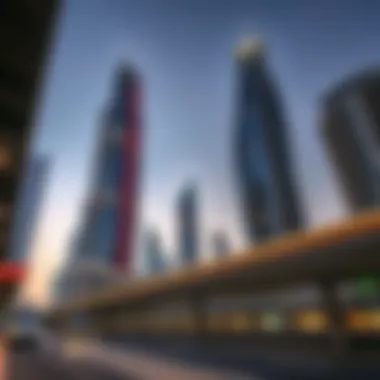
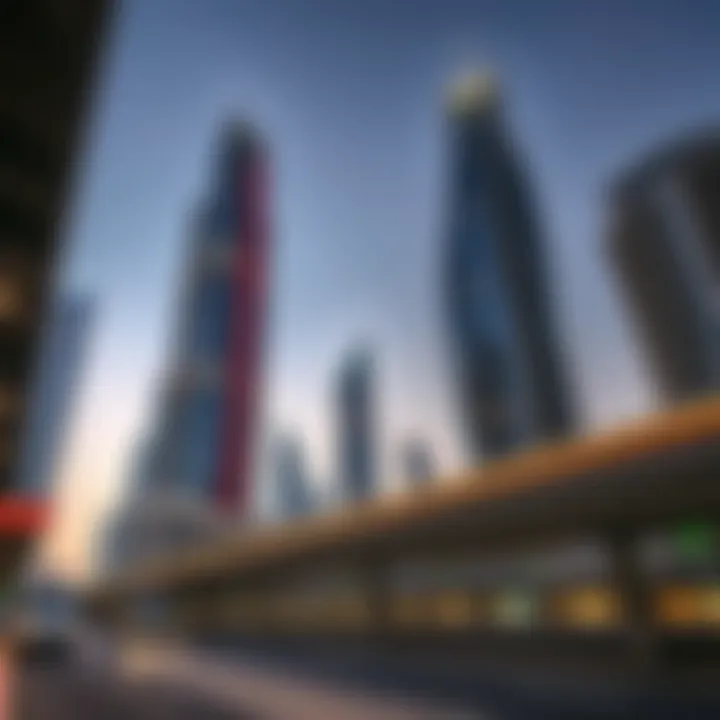
One significant anticipated development involves the expansion of existing stations and the addition of new ones. This initiative is particularly beneficial because it connects underserved areas, making the Metro more accessible for different communities.
- Integration with Other Transport Modes: Expanding the Metro system can enhance connectivity with buses, taxis, and bicycles, encouraging more sustainable transport choices.
- Infrastructure Modernization: Advanced technologies may be integrated into the system, such as smart ticketing solutions that simplify the user experience. Such advancements can attract more users to the Metro, bolstering revenues further.
- Environmental Benefits: Improvements aimed at reducing emissions and energy consumption reflect Dubai’s long-term sustainability goals, making them a smart investment.
Public Feedback and Involvement
Public feedback plays a critical role in the enhancement of the Metro system. Not only do insights from the community directly impact user satisfaction, but they also guide future changes and expansions.
- Engagement Channels: Forums, surveys, and community meetings serve as platforms for residents to voice their opinions, helping decision-makers to gauge public sentiment regarding current services and future upgrades.
- Tailored Solutions: By listening to commuters’ experiences and suggestions, planners can focus on areas that need improvement—whether that’s more frequent service times or added amenities at stations.
- Community Ownership: When the public feels involved, they’re more likely to support and advocate for the Metro system. This can lead to greater riders’ loyalty and increased overall satisfaction rates.
"Investing in commuter input not only helps in smooth operations but cultivates a sense of ownership among residents."
In summary, the challenges and considerations facing the Metro Red Line highlight the importance of strategic planning. Maintenance and operational costs, paired with proactive approaches to upgrades and community involvement, ensure that this vital transportation link continues to serve Dubai’s evolving needs effectively.
Sustainability and Environmental Impact
The Metro Red Line in Dubai is more than just a means of transportation; it is a pivotal component in the fight for sustainability and environmental awareness. As urban populations expand, cities face growing challenges regarding pollution, traffic, and resource consumption. Consequently, it is vital to explore how the Red Line not only alleviates these issues but aligns with broader environmental goals. Awareness about sustainability is becoming ever more pressing in today’s climate-driven world, especially in rapidly developing metropolises like Dubai.
Eco-Friendly Initiatives
The Metro Red Line embodies numerous eco-friendly initiatives that collectively strengthen its role in promoting sustainable urban living. Here are some noteworthy examples:
- Energy Efficiency: The trains are designed to minimize energy consumption. Each train uses regenerative braking systems which convert kinetic energy back into electrical energy, drastically reducing the overall energy usage.
- Solar Panels at Stations: Many stations along the Red Line feature solar panels that harness energy from the sun. This initiative not only cuts down reliance on non-renewable energy sources but also reduces operational costs in the long run.
- Sustainable Materials: During construction, a significant focus was placed on utilizing sustainable materials. This includes the use of recycled materials and structures that allow for natural lighting, further reducing energy needs for illumination.
- Green Spaces: Several stations are complemented by surrounding green spaces, creating a more harmonious blend within the urban landscape. Such areas not only improve air quality but also provide residents with nature-rich environments to enjoy, encouraging a lifestyle that values the outdoors.
These initiatives are emblematic of the overall mission behind the Metro Red Line—to establish a public transport system that is not merely functional but also environmentally conscious.
Link to Dubai's Vision for Sustainability
Dubai’s strategic focus on sustainability is explicitly articulated in the Dubai Clean Energy Strategy 2050. Within this framework, the Metro Red Line plays a crucial role by providing an efficient transport alternative that curbs greenhouse gas emissions. The following points illustrate how the Red Line aligns with Dubai's ambitious vision:
- Public Transport Usage: Promoting the use of public transit reduces the number of vehicles on the road. This decrease is paramount for reducing traffic congestion—which is a significant issue in Dubai—and subsequently leads to lower carbon emissions.
- Integration with Other Initiatives: The metro system is expertly tied with other sustainability efforts in Dubai, including the Dubai 2040 Urban Master Plan. This plan envisages a city that emphasizes compact communities and low-carbon developments, which the Metro system supports by enhancing access to both residences and business districts.
- Community Engagement: The Dubai Metro's commitment to sustainability also extends to educational programs aimed at raising awareness about environmental issues among residents and visitors alike. Through events and campaigns, it fosters a culture of sustainability throughout the city.
User Experience and Feedback
The experiences and feedback of users are pivotal in gauging the success and efficiency of the Metro Red Line in Dubai. It provides a window into the minds of commuters regarding daily usage, service quality, and overall satisfaction. Understanding these aspects enhances the operational vision of the metro and helps stakeholders make informed decisions.
Commuter Testimonials
To genuinely appreciate the strengths and weaknesses of the Metro Red Line, it's useful to hear directly from those who navigate its routes daily. Many commuters share their thoughts on social media platforms and forums, adding a human element to the numbers. For instance, one rider might highlight how quick and efficient the trains are, making it a preferred mode of transport for busy professionals. Another may express concerns regarding overcrowding during peak hours, pinpointing times which lead to a frustrating experience.
Additionally, reviews often reveal patrons' insights on cleanliness and safety, which are significant factors influencing public transport usage. Some commuters rave about how well-maintained the stations are, while others have raised issues about delays. Here are some recurring sentiments gathered from various voices across stations:
- Convenience: “It’s easier than driving. No traffic jams, just hop in and go.”
- Punctuality: “Most of the time, the trains are on time. But some mornings, it feels like an eternity waiting.”
- Safety: “I feel safe riding the Metro, especially during the night.”
- Crowding: “It can get packed during rush hour, making it a tad uncomfortable.”
Factors Influencing Satisfaction
Understanding satisfaction levels involves more than simply counting the number of riders boarding the trains. It dives deeper into elements that shape commuting experiences. Key factors include:
- Service Quality: Regular maintenance of trains ensures that the service remains efficient. Any breakdowns or malfunctions can lead to significant dissatisfaction.
- Frequency of Trains: A frequent schedule is essential for unburdened rides. If a train shows up every five minutes, it minimizes long waits and anxiety about being late.
- Accessibility: How effectively the Metro accommodates diverse groups is vital. For example, facilities for disabled persons and senior citizens can greatly enhance user experience.
- Information Availability: Clear signage and real-time updates about schedules can make a big difference in how travelers perceive their journey. Commuters value communication regarding delays or changes in service.
"A satisfied commuter is not just a passenger; they're an advocate for the system."
By evaluating these aspects, the Metro operators can adjust and innovate in ways that resonate well with users. This in-turn positively impacts ridership and the overall perception of public transport in Dubai.
Epilogue
The experience of using the Metro Red Line goes beyond mere transportation; it influences the dynamics of the very fabric of Dubai. This section summarizes the key takeaways discussed in the article and looks ahead to what the future holds for this vital infrastructure.
Summary of Key Points
- Metro Red Line Overview: The Red Line is a critical component of Dubai's metro system, stretching from Rashidiya to UAE Exchange, connecting key districts and promoting accessibility.
- Impact on Urban Development: The line has spurred a boom in real estate prices in areas adjacent to its stations, making properties within a stone's throw of the metro line increasingly attractive for investment.
- Socioeconomic Benefits: It plays a significant role in tourism, serves commuters efficiently, and contributes to a more sustainable urban environment.
- Challenges: Like any other infrastructure, it faces its fair share of challenges, including maintenance costs and the need for future expansions.
Future Outlook for the Red Line
The future of the Metro Red Line appears promising. With a growing population and increasing demand for efficient transport, enhancements are expected to bolster its importance even further. Strategic upgrades could include:
- Expanding Connections: Future plans may incorporate additional extensions that link to new districts or integrate with upcoming projects like the Dubai Creek Harbour. Such moves would support the city’s expansion strategies.
- Technology Integration: Smart technologies may further streamline operations, improve user experience, and make real-time data available to commuters. This will enhance the overall effectiveness of the metro.
- Sustainability Initiatives: As Dubai continues to push its sustainability agenda, the Metro Red Line is expected to align with green goals, possibly integrating solar technologies and energy-efficient systems.
Overall, stakeholders—including investors, homeowners, developers, and realtors—should remain observant of these developments, as they hold significant implications for property values and urban life in Dubai. The Red Line is not just a transit route; it represents a cornerstone for future growth and transformation in this vibrant metropolis.







